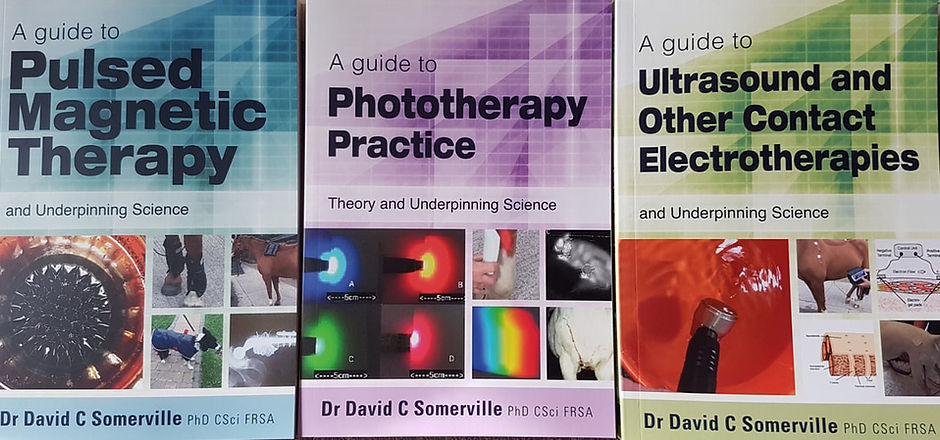PULSED MAGNETIC FIELD THERAPY - HOW DOES IT WORK?
An extract taken from a lecture delivered on 28th January, 1995by Dr. D. C. Somerville Ph.D. (Med. Eng.); MBES; MIPEM*;B.Ed. (Hons)(Phys. Sciences); CGLI (Ind. Electronics);Consultant Clinical Engineer, Westville Associates and Consultants (UK).All living cells within the body possess potentials between the inner and outer membrane of the cell, which, under normal healthy circumstances, are fixed. Different cells, e.g. Muscle cells and Nerve cells, have different potentials of about -70 milli-Volts respectively. When cells are damaged, these potentials change such that the balance across the membrane changes, causing the attraction of positive sodium ions into the cell and negative trace elements and proteins out of the cell. The net result is that liquid is attracted into the interstitial area and swelling or oedema ensues. The application of pulsed magnetic fields has, through research findings, been shown to help the body to restore normal potentials at an accelerated rate, thus aiding the healing of most wounds and reducing swelling faster. The most effective frequencies found by researchers so far, are very low frequency pulses of a 50Hz base. These, if gradually increased to 25 pulses per second for time periods of 600 seconds (10 minutes), condition the damaged tissue to aid the natural healing process.Pain reduction is another area in which pulsed electromagnetic therapy has been shown to be very effective. Pain signals are transmitted along nerve cells to pre-synaptic terminals. At these terminals, channels in the cell alter due to a movement of ions. The membrane potential changes, causing the release of a chemical transmitter from a synaptic vesicle contained within the membrane. The pain signal is chemically transferred across the synaptic gap to chemical receptors on the post synaptic nerve cell. This all happens in about one 2000th of a second, as the synaptic gap is only 20 to 50 nanometres wide (1 nanometre = 1/1000,000,000 of a metre). As the pain signal, in chemical form, approaches the post synaptic cell, the membrane changes and the signal is transferred. If we look at the voltages across the synaptic membrane then, under no pain conditions, the level is about -70 milli-Volts. When the pain signal approaches, the membrane potential increases to approximately +30 milli-Volts, allowing a sodium flow. This in turn triggers the synaptic vesicle to release the chemical transmitter and so transfer the pain signal across the synaptic gap or cleft. After the transmission, the voltage reduces back to its normal quiescent level until the next pain signal arrives.The application of pulsed magnetism to painful sites causes the membrane to be lowered to a hyper-polarisation level of about -90 milli-Volts. When a pain signal is detected, the voltage must now be raised to a relatively higher level in order to fire the synaptic vesicles.Since the average change of potential required to reach the trigger voltage of nearly +30 milli-Volts is +100 milli-Volts, the required change is too great and only +10 milli-Volts is attained. This voltage is generally too low to cause the synaptic vesicle to release the chemical transmitter and hence the pain signal is blocked. The most effective frequencies that have been observed from research in order to cause the above changes to membrane potentials, are a base frequency of 200Hz and pulse rate settings of between 5 and 25Hz.*Member of the Institute of Physics and Engineering in Medicine

The Biomag 2 System has been developed over the last 26 years. Chartered Scientist, Dr David C Somerville, CGLI (Final) Industrial Electronics, DipHE (Physics and Chemistry), BEd(Hons), MSc*, PhD, CSci, MIPEM, FRSA (who studied physics, chemistry and education, who was also an RAF qualified avionics engineer). He used used his knowledge and experience to develop the system after studying for an MSc* in Orthopaedic Mechanics then gaining a Doctorate in Clinical Orthopaedic Research. He then went into university lecturing including post-doctoral supervision and research into the analysis and treatment of non union fractures and osteoporosis using pulsed electromagnetic inductive therapy.
The name Westville is a combination of David’s wife and business partner Marjorie’s maiden name ‘West’ and the ‘Ville’ from his own surname, hence Westville. It was established in 1995 as a business.
*Completed but then transferred and incorporated into PhD studies.
David is the author of three books shown above: ‘A Guide Pulsed Magnetic Therapy and Underpinning Science’ and ' A Guide to Phototherapy Practice Theory and Underpinning Science 'and ' A Guide to Ultrasound and other Contact Therapies and Underpinning Science'

